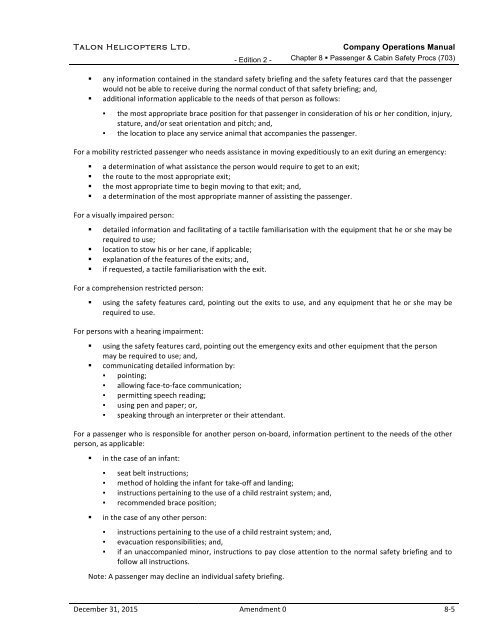Talon Helicopters Ltd COM Edition 2 Amend 0 submission 3 TC Stamped
You also want an ePaper? Increase the reach of your titles
YUMPU automatically turns print PDFs into web optimized ePapers that Google loves.
<strong>Talon</strong> <strong>Helicopters</strong> <strong>Ltd</strong>.<br />
- <strong>Edition</strong> 2 -<br />
Company Operations Manual<br />
Chapter 8 § Passenger & Cabin Safety Procs (703)<br />
§ any information contained in the standard safety briefing and the safety features card that the passenger<br />
would not be able to receive during the normal conduct of that safety briefing; and,<br />
§ additional information applicable to the needs of that person as follows:<br />
▪<br />
▪<br />
the most appropriate brace position for that passenger in consideration of his or her condition, injury,<br />
stature, and/or seat orientation and pitch; and,<br />
the location to place any service animal that accompanies the passenger.<br />
For a mobility restricted passenger who needs assistance in moving expeditiously to an exit during an emergency:<br />
§ a determination of what assistance the person would require to get to an exit;<br />
§ the route to the most appropriate exit;<br />
§ the most appropriate time to begin moving to that exit; and,<br />
§ a determination of the most appropriate manner of assisting the passenger.<br />
For a visually impaired person:<br />
§ detailed information and facilitating of a tactile familiarisation with the equipment that he or she may be<br />
required to use;<br />
§ location to stow his or her cane, if applicable;<br />
§ explanation of the features of the exits; and,<br />
§ if requested, a tactile familiarisation with the exit.<br />
For a comprehension restricted person:<br />
§ using the safety features card, pointing out the exits to use, and any equipment that he or she may be<br />
required to use.<br />
For persons with a hearing impairment:<br />
§ using the safety features card, pointing out the emergency exits and other equipment that the person<br />
may be required to use; and,<br />
§ communicating detailed information by:<br />
▪ pointing;<br />
▪ allowing face-to-face communication;<br />
▪ permitting speech reading;<br />
▪ using pen and paper; or,<br />
▪ speaking through an interpreter or their attendant.<br />
For a passenger who is responsible for another person on-board, information pertinent to the needs of the other<br />
person, as applicable:<br />
§ in the case of an infant:<br />
▪<br />
▪<br />
▪<br />
▪<br />
seat belt instructions;<br />
method of holding the infant for take-off and landing;<br />
instructions pertaining to the use of a child restraint system; and,<br />
recommended brace position;<br />
§ in the case of any other person:<br />
▪<br />
▪<br />
▪<br />
instructions pertaining to the use of a child restraint system; and,<br />
evacuation responsibilities; and,<br />
if an unaccompanied minor, instructions to pay close attention to the normal safety briefing and to<br />
follow all instructions.<br />
Note: A passenger may decline an individual safety briefing.<br />
December 31, 2015 <strong>Amend</strong>ment 0 8-5


